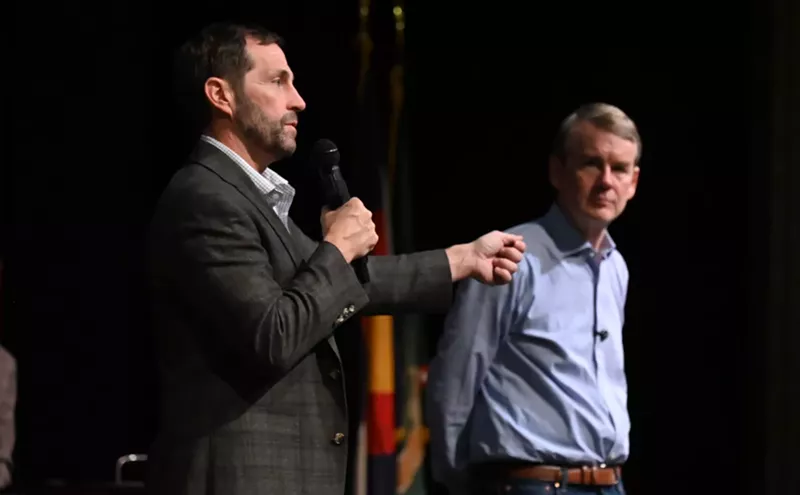Coincidentally, that's what killed him Saturday.
But not before he gave Denver two decades of wonderful memories, energizing the town with his ebullience, his wit, his imagination, his generous spirit and, above all, his stories.
Some of the best never made it to print.
Since his death, people have been swapping Dumas stories the way collectors share precious items. The time he argued with a usually dead-serious writer over whether The A-Team or Star Trek represented the "apotheosis" of civilization. (A clue to Dumas's position: What do you think the "A" in A-Team stands for?) The time he told us about his date with John Wayne's daughter, which ended with the Duke himself coming out to chaperone. The time he became an ordained minister, just so he could conduct the marriage ceremony for a friend who tap-danced down the aisle. ("All the stories I remember are funny or nice," that friend marvels. "He didn't have a mean bone in his body.") The time he became a member of Maria Shriver's "posse" of wacky reporters--necessitating the purchase of a safari jacket--for a short-lived NBC show. The time he reprised his high school Henry Higgins for the Westword Christmas play, My Fair Sales Rep, and bellowed out, "The pantyhose goes mainly on the toes." The time he told us that he was descended from a very aristocratic French family, and the way you could tell was because all male members had three testicles. (You should have seen the coroner's face when I asked about that.) The time he turned down a morning drive-time gig at a rock station for a full-time job at Westword that paid about one-tenth as much. It was principle, he said. (He'd later leave us to follow another love, talk radio, before landing at the Rocky Mountain News a decade ago.)
I've been collecting Dumas stories since September 1, 1977, when he wrote for the debut issue of Westword. He was our first theater critic--netting us our first libel suit when he wrote that a certain dinner theater served up "theater by and for morons." But although he loved the theater and acted some himself--Dumas's local performances, particularly a lengthy pukefest at the start of Macbeth, are understandably the stuff of legend--he didn't limit himself to such esoteric fare. He tackled topics ranging from why he hated summer--among other reasons, "overweight girls clad in hooter bags and cutoffs," a comment that earned us our first angry-letters campaign--to James Bond to UFOs to Blinky the Clown. He even did some investigative reporting. Or so he told us.
But Alan Dumas was at his best when he was telling a story. And he rarely let the truth get in the way of a good one, particularly if he was the central character.
Feeling in the holiday spirit in December 1983, he decided to go undercover as Santa. So he contacted a local Rent-a-Santa program, which surely had no idea what it was agreeing to, and began brushing up on his acting exercises: testing out his transference, searching for subtext, retrieving "sense memory." The result was "I Was a Method Santa":
Like many other young men, when I was 18 years old I wanted to be an actor. In pursuit of that dream I was fortunate to be accepted as a member of the Actor's Studio West in Los Angeles. I would probably still be there if [Lee] Strasberg himself hadn't taken me out one night for a cup of coffee and advised me to look for another line of work. I was young and impressionable, so I took his advice. I have always regretted it, although there's not a whole lot you can do when the head of the Actor's Studio tells you to take a hike. Nevertheless, in the years since my brief career on the stage ended, I have always said I would return if I found a role I felt worthy of my misjudged abilities.
Enter Santa.
The moment of truth arrives. I take my chair and a little boy climbs on my lap, his mother beaming at us and snapping pictures with her Instamatic.
"Hello, Santa," says the boy, smiling. I am silent. A feeling of panic has overtaken me. The boy looks disconcerted.
"My name is Billy," says the child. "Aren't you going to say anything?"
"I just don't understand my motivation," I say, shocked to realize I've spoken aloud.
"What's motivation?" asks the boy.
"Well, son, motivation is the subconscious drive of a character that an actor must understand before he can give a believable performance."
Billy is getting suspicious. "Are you really Santa Claus?" he asks.
"Of course I'm Santa Claus. Ho Ho Ho," I reply. The show must go on. "What do you want for Christmas, Billy?"
"A GI Joe set," he answers promptly.
At last a break. I played with a GI Joe when I was a kid, at least until my mother caught me having Joe make time with my sister's Barbie. This was a memory. I could hear Strasberg whispering in my ear: "It's a memory. Use it."
"A GI Joe," I say. "That's a fine present, Billy. Does your sister have any Barbie dolls?"
But even this experience was not enough to send Dumas's Santa packing. Years later he was playing the Jolly Old Elf on a radio broadcast when a kid in the studio was having trouble coming up with a wish list. So Santa offered a helpful prompt: "Might you be interested in any rubber goods?" In November 1988, Dumas wrote a story about a guy in a Santa suit picketing an insurance company that was so disgustingly heartwarming I typed this note for the proofreader at the story's end: "I can't decide whether to puke or laugh. Do what you will." What she did was somehow let that editorial comment slip into print.
Every day was Christmas when Dumas was around. You just weren't sure what the next package would contain.
In early July 1987, it was a very smelly Dumas, fresh from a week on the Green Tortoise. Here's how Dumas found himself on the bus:
I was getting old. I was getting stodgy. We had moved to a house in what might as well be the suburbs, and I was pricing weed trimmers. One night the phone rang. I tripped over some upholstery swatches and grabbed it. My little brother, an unreconstructed hippie, was babbling away about a bus ride some of his friends had taken aboard the Green Tortoise, a secret relic of the Seventies that still crosses the country eight times a year, passing through Colorado. While he spoke of love-ins and scenic sunrises, I eyed my new shag carpeting. I decided a needed a vacation.
Dumas got on board in Glenwood Springs. Nothing in my experience has prepared me for the cramped, muddy, squalid, claustrophobic horror before me. These are the guts of the Green Tortoise.
The seats have been ripped out and replaced with a plywood platform that extends two-thirds of the length of the bus. This is fronted by a couple of tables with (as I discover) excruciatingly uncomfortable benches. Although there are a few overhead racks for luggage, every square inch of the place is piled high with dirty clothes, packs, purses, sleeping bags, dirty socks, old shoes and miscellaneous garbage. Enjoying this feculence are dozens of large black ants.
I wake up at dawn with my arms around a 200-pound German who looks like Arnold Schwarzenegger's little brother. Pressed against my back is a mostly naked teenaged girl whose nationality escapes me. Since there's no privacy on the Green Tortoise, such civilized concepts as modesty disappear. Snuggling a little further away from Arnie Jr. and a little closer to person unknown, I wonder if what we have here is a rolling version of Lord of the Flies. One by one the layers of civilization are being stripped away. When the bus reaches California, will it disgorge a bunch of savage aborigines?
There's no time to pursue this theory. I've noticed that as we slept, the army of black ants has grown larger. I point this out to one of my fellow Americans.
"It's true, man," he says. "We pick up lots of companions on this trip."
The year before, Dumas--and through him, Westword readers--had made the acquaintance of a man who didn't need much companionship. Brain researcher T.D. Lingo could take care of himself:
Some night in the mountains around Blackhawk, you might hear a terrible sound. It is a huge, hoarse bellow that builds to an ear-shattering crescendo, then tapers off to a whimper: rrrAWWWWWWWWWrrrr. This tortured noise will echo over and over for an hour or more. But do not be afraid. It is not a wild beast or some terrible mutant caused by radiation from Rocky Flats.
It is just T.D. Lingo having 250 orgasms.
Mankind has never come to grips with two sad, incontrovertible facts.
The first is that human beings only use about 10 percent of their brains. The second is that human males reach their sexual peak at the age of seventeen.
We tend to tuck these facts into the unused part of our minds because they're a little depressing, and because we believe there's nothing we can do to change the situation.
But here is a man who says we can learn to use all that dormant grey matter sitting inside our heads, in the process undergoing a physical metamorphosis that allows men and women of all ages to experience up to 250 orgasms every time they engage in sex...
Dumas was very interested in the Lingo story. But he also loved writing about grime, gloom and impending doom. Although he was quite certain he'd die from an unexpected attack of appendicitis in a remote area--say, aboard the Green Tortoise--he explored alternative, equally ghoulish deaths. Being eaten by bears, for example. (He revisited that subject many times during his years at Westword.) Or succumbing to the plague, a pressing issue he pursued in March 1987:
It's springtime in the Rockies. People gratefully leave their homes to walk in the sunshine, trading their skis for hiking boots. The parks fill up and backyard barbecues blaze.
Around the city, animals come out of hibernation, too. Squirrels climb down from their trees, rabbits emerge from their burrows, chipmunks, mice and other creatures of the field begin foraging in the warm grass.
But below ground, in those rodent burrows, something more sinister lurks. Kept alive through the winter in the dark, humid dens of hibernating animals, it awakens to its grim task, a task it has ruthlessly and efficiently accomplished for many thousands of years: Death. Springtime in the Rockies is plague season.
The Bubonic Plague. The Black Death. Man's oldest and deadliest enemy...
Dumas was quite proud when one of the scientists quoted in that story called to complain that it was most irresponsible piece of journalism he'd ever read. The poor man had no idea.
Nor did we, when in June 1979, the Duke-worshiping Dumas came to us with a hot, hot news tip about his recently departed hero:
John Wayne's death-bed conversion to Roman Catholicism has caused a stir among Catholics nationwide. To have a man of Wayne's stature join the ranks of the faithful was considered a great boost to the Church's prestige in this country. So it is not all that surprising to find a Denver group lobbying for Sainthood for the Duke.
James Sullivan, of Our Lady of Lourdes parish, is leader of the movement. "We are not asking for Mr. Wayne's veneration because we want him canonized," said Sullivan, "although we would eventually like to see this happen if he meets the requirements for Sainthood. We just think the Church should bestow some special honor on a Catholic of such importance and stature."...
It is possible the Church needed John Wayne as much as John Wayne needed the Church. At the last minute, maybe the Duke accepted a commission in the greatest army of all.
Puke or laugh.
A few days later, Gene Amole, then just at the start of his long career as the Rocky Mountain News's lead columnist, wrote a piece based on Dumas's scoop. And a few days later, Time magazine called. They wanted to follow the story, too. Could we put them in touch with the priest?
Since Westword was still in its infancy, we thought getting noticed by Time was the bigtime. We called Dumas, told him the great news and asked for the priest's number.
"I'm afraid I can't give it to you," he said.
At the time, Dumas was very tweedy, very Bob Woodwardly, and we understood his reluctance to give up a source. But this was for Time, we stressed; sharing the information would be a professional courtesy.
"No," he replied in that basso profundo voice, taking off his glasses and giving us the most sincere look possible with his big baby blues ("the color of spit," he'd say, being a fan of Travis McGee). "No, I can't give it to you because I made it up."
Our shrieks pierced glass. His giggle reached the same level.
Like John Wayne, Alan Dumas was no saint.
But he had a heart so big you could forgive him anything.
Denver is a better city because he shared it with us. He brought us nothing but joy, laughter and stories.
Never-ending stories.
Services for Alan Dumas are scheduled for 1 p.m. Thursday, April 22, at Holy Ghost Church, 1900 California Street. For more information, log on to http://home.earthlink.net/~gillers/dumas.html












